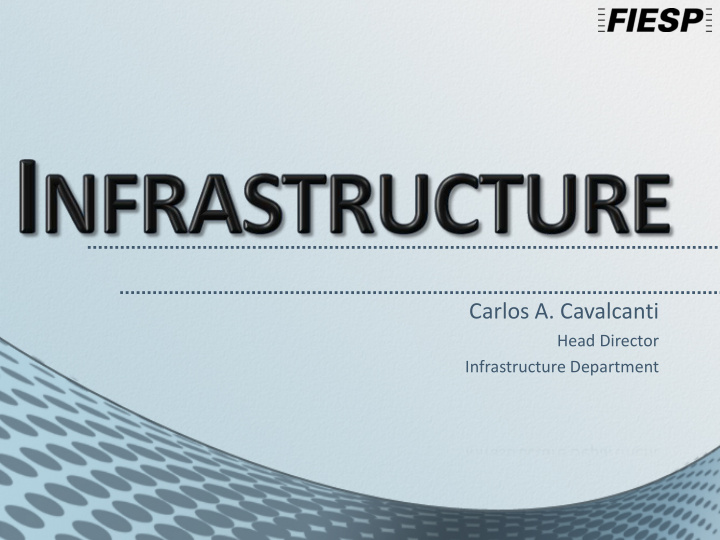



Carlos A. Cavalcanti Head Director Infrastructure Department
S OUTH A MERICA O VERVIEW Total Area: 18 million km 2 Population: 384 million Economy Growth: 5%/year (2002 - 2010) GDP Growth: 24% (2003 - 2010) Represents : 6% of global GDP (2010) and 17% of America GDP (2010)
T RANSPORTATION Due to its natural conditions, the country has great potential to develop, diversified, competitive and clean transportation and logistics system. Source: Ministry of Transportation of Brazil 2011
T RANSPORTATION B RAZILIAN T RANSPORTATION S ECTOR Current Investments: 0.7% of GDP Source: Brazilian Institute for Applied Economic Research, 2012
T RANSPORTATION UNASUR - U NION OF S OUTH A MERICAN N ATIONS COSIPLAN South American Infrastructure and Planning Council API Integration Priority Project Agenda More than US$ 8 integration hubs 21 31 structural projects billion 88 individual projects in infrastructure projects
T ELECOM A TLANTIC C ABLE S YSTEM (ACS EA ) • Brasil: USA – Southern Cone – Africa – Europe • Estimated in US$ 884 mi • 24,000 km of submarine cables • Operation: 2014 • Possible extension from Angola.
T ELECOM T HE O PTICAL R ING S YSTEM • Strategic project North America • Direct network connection of the UNASUR countries • Cost reduction in data traffic South America • Increase of data security and traffic speed • Conclusion: 2015
T ELECOM DTV • Technology unification in South America • Brazil : ISDB-T system • Colombia: DVB- T • Heading for a regional standard
E NERGY AND C LIMATE C HANGE GHG E MISSIONS : A SECTORAL APPROACH Two thirds (66%) 4% 3% of global GHG 13% emissions result from energy production 14% Energy Agriculture Changes in land use and forests Industrial Processes Waste Source: Prepared by FIESP based on Houghton and IEA (2005)
E NERGY M IX O VERVIEW Renewables 100% represents 90% 48% 80% 70% in the 60% energy mix 50% 40% Biofuels and Waste Other 30% Hydro Nuclear 20% Natural Gas 10% Oil Coal and Peat 0% World South America Brazil Source: Prepared by FIESP based on IEA (base year 2009) and OLADE (base year 2010)
P OWER G ENERATION O VERVIEW 100% 89% 90% 80% of renewable 70% power 60% generation 50% 40% Coal and Peat Oil 30% Natural Gas Nuclear 20% Biomass Hydro 10% Wind Other 0% World South America Brazil Source: Prepared by FIESP based on IEA (2009)
H YDROELETRIC REGIONAL POTENTIAL Total: 590 GW Brazil Colombia Peru Venezuela Argentina Ecuador Chile Paraguay Bolivia Guyana Suriname Uruguay Source: OLADE`s Energy Information System 2011 (base year 2010)
B RAZILIAN P OWER G RID Isolated System Less than 2% Source: ONS 2009
R EGIONAL E LECTRIC P OWER I NTEGRATION Venezuela Interconnection Situation MW Colômbia Argentina 5 1. Garabi I Working 1018 Equador 2. Garabi II Working 1160 3. Uruguaiana Working 50 10 Brasil 4. UHE Garabi In study 1200 Peru Venezuela 5. Boa Vista Working 200 Bolívia 8 Uruguai 9 Paraguai 6. Rivera Working 70 1,2,4 7. San Carlos In study 500 3 Paraguai 6 Uruguai Argentina 8. Foz Iguaçu Working 50 7 Chile 9. Itaipu Working 6300 Peru 50Hz 10. Projetos Hidro In study 7564 60Hz Source: ONS 2009
B IOFUELS IN B RAZIL Flex Fuel vehicle producers Production: 22 billion liters of ethanol in 2011 Use of sugarcane ethanol: E20 and Flex Fuel Technology Production: 2.6 billion liters of biodiesel in 2011 5% of Biodiesel blend Since 2010 Source: UNICA 2012, ANP 2012 / ANFAVEA 2011
B IOFUELS IN S OUTH A MERICA Ethanol Mandates Biodiesel Mandates Argentina 5% Argentina 5% Bolivia ----- Bolivia 2,5% Brazil 20% Brazil 5% Colombia 10% Colombia 7-10% Chile 2-5% Chile 2-5% Ecuador 10% Ecuador 2,5% Paraguay 18-24% Paraguay 5% Peru 7,8% Peru 2% Uruguay ----- Uruguay 2% Source: IICA 2010
N ATURAL G AS S HALE G AS P ERSPECTIVES Proved Technically Natural Gas Recoverable Shale Reserves Gas Resourses (trillion cubic feet) Venezuela 178.9 11 Colombia 4.0 19 Argentina 13.4 774 Brazil 12.9 226 Chile 3.5 64 Uruguay 21 Paraguay 62 Bolivia 26.5 48 Source: U.S.EIA 2011
G AS P IPELINES I NTEGRATION BOLIVIA Pacific Ocean Gas Pipeline of Northeastern Argentina Gas Pipeline Project (main) Gas Pipeline Project (branch) National Capital City Existent Gas Pipeline Hydrography Border Map: FIESP 2012
P RE -S ALT Total Depht from 5000 m to 7000 m Source: Petrobras
P RE -S ALT Water Depht Pos Salt: ranging from ±1000m 1900 Salt Layer: to Up to 120 2400 ±2000m meters billion barrels Source: Petrobras
Carlos A. Cavalcanti Head Director Infrastructure Department energy@fiesp.org.br
Recommend
More recommend